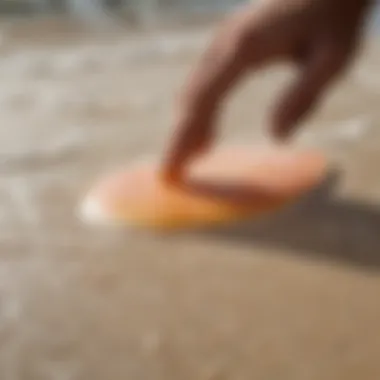The Definitive Guide to Skim Board Wax: Enhancing Performance and Durability


Intro
The world of skimboarding is not just about balance and skill; it also demands the right equipment to truly harness the essence of the sport. At the heart of this equipment is skim board wax. This guide assesses how skim board wax is vital in enhancing performance and durability, offering insights for both beginners and seasoned skim boarders. Understanding different types of wax and how to apply them correctly can drastically change your skimboarding experience.
Skimboard Wax Fundamentals
Skimboard wax serves a crucial purpose. It provides grip, ensuring that riders do not slip off the board while performing tricks or gliding over waves. The consistency of the wax is also important. Softer waxes tend to work well in cooler conditions, while harder waxes are better suited for warmer climates.
Types of Skimboard Wax
- Basecoat Wax: This type is often used as a foundation layer. It sticks to the board and allows the topcoat wax to adhere effectively.
- Topcoat Wax: It is designed for ultimate grip and is applied over the basecoat. This wax can be tailored for specific conditions depending on the temperature and water state.
- All-Temperature Wax: A versatile option, this wax is formulated to work in varying conditions, making it a convenient choice for many skimboarders.
Key Application Techniques
Proper application of wax is essential to maximize its benefits. Here's how you can ensure you are waxing your skimboard effectively:
- Clean Surface: Always start with a clean board. Remove any old wax and debris before applying new.
- Basecoat Application: Apply a thin layer of basecoat wax evenly across the areas of the board you will step on.
- Topcoat Layering: After basecoat, add a layer of topcoat wax. Use circular motions to create a textured surface for grip.
Impact of Environmental Factors
Environmental conditions can influence wax performance. Factors like water temperature, air humidity, and even the type of sand at a skimboarding spot play significant roles. For example, warmer climates might require a harder wax to maintain that much-needed grip without melting. This knowledge allows skimboarders to choose wax more adeptly and prepare accordingly.
"Choosing the right wax for the conditions can significantly enhance your performance on the water."
Maintenance and Care
Taking care of your skimboard extends its lifespan and enhances the effectiveness of the wax. Regular cleaning and proper storage can prevent costly repairs down the road. Here are some tips:
- Cleaning: Use a soft brush or cloth to remove sand and water after each session.
- Inspect Regularly: Search for dings and cracks, which if left unchecked, can worsen.
- Storage: Keep your board in a cool, dry place to avoid heat damage or warping.
The End
In sum, the right skimboard wax not only improves grip but also contributes to the overall longevity of your board. Understanding the various types of wax and their specific conditions empowers skimboarders to make educated choices that can enhance their experience on the water. By following the guidelines for proper application and maintenance, you ensure that both your performance and your equipment remain top-notch.
Understanding Skim Board Wax
In the realm of skimboarding, the choice of wax is often overlooked. However, understanding skim board wax is crucial for optimizing performance and ensuring the longevity of your equipment. This guide unpacks the intricacies of skim board wax, highlighting its role in enhancing grip, speed, and overall riding experience. Moreover, it lays the foundation for appreciating the nuances in different types of wax and the application techniques that can significantly alter one’s performance on the water.
Definition and Purpose
Skim board wax serves as a friction-enhancing agent that allows riders to maintain better control over their boards. The primary purpose of this wax is to create a grippy surface that prevents slipping during maneuvers and aids in executing tricks. Without appropriate wax, riders may struggle even in calm water conditions; hence, it is an essential aspect of skimboarding. Moreover, it helps to prolong the lifespan of the board by providing a protective layer against the elements and abrasions.
Composition of Skim Board Wax
The composition of skim board wax significantly affects its performance and suitability for various conditions. It often consists of several materials, each contributing uniquely to the wax's overall performance.
Types of materials used
Skim board wax typically comprises paraffin, microcrystalline wax, and additives like rosin or polymers. Paraffin wax, known for its flexibility, forms the base. It adapts to changes in temperature and provides a reliable grip. Microcrystalline wax adds durability and resistance to wear, making it a popular choice for high-performance applications. The inclusion of additives enhances the wax's effectiveness in specific conditions, such as wet or dry surfaces. Each of these materials plays a vital role, and understanding them can influence your choice when selecting the right wax.
Chemical properties
Chemical properties of skim board wax dictate its performance characteristics. The melting point, hardness, and viscosity of the wax are all essential factors. Skim board wax with a higher melting point tends to perform better in warmer conditions, preventing it from becoming too soft or losing grip. Conversely, softer wax works well in cooler conditions, creating better traction on cooler surf. Additionally, the chemical composition can influence how the wax interacts with water, impacting its overall effectiveness. Selecting the right wax based on these chemical properties ensures optimal performance while riding.


Types of Skim Board Wax
Understanding the various types of skim board wax is crucial for any enthusiast looking to enhance their performance and the durability of their equipment. Each type of wax serves a specific purpose and comes with its benefits and drawbacks. Selecting the appropriate wax can significantly affect how you glide over water, how much grip you achieve, and ultimately how much enjoyment you get from your time on the water. Let’s delve into three main types of skim board wax: soft wax, hard wax, and temperature-specific wax.
Soft Wax
Characteristics
Soft wax is known for its pliability and grip. It is typically softer in texture, making it easy to apply and mold onto the board's surface. One key characteristic of soft wax is its ability to provide excellent traction, which is vital for maintaining footing when performing tricks or riding waves. This quality makes it a beneficial option for beginner to intermediate riders who need that added stability and safety. The unique softness also invites a quick application, allowing for rapid re-waxing. However, the downsides include it wearing off faster than harder waxes, especially in warmer conditions.
Best usage scenarios
Soft wax works well in cooler water or for less aggressive riding situations. The main advantage occurs when skimboarding on softer, less aggressive terrain or smaller waves. The wax’s softness allows for increased control, making it a popular choice among novice skimboarders. Yet, it might not hold up as effectively during high-performance or competitive scenarios, where a firmer grip is essential.
Hard Wax
Characteristics
Hard wax, as the name implies, is firmer and more resilient than its softer counterpart. It provides a unique feature of longer-lasting durability, standing up better against the rigors of competitive skimboarding. The firmness contributes to a consistent grip, which many find essential when performing tricks. However, applying hard wax requires a bit more effort, requiring time and technique to achieve a smooth finish.
Best usage scenarios
This type of wax excels in warmer climates and during intense riding sessions. Hard wax is favored by seasoned boarders who engage in high-speed maneuvers and desire a stable grip on various surfaces. However, less experienced riders might struggle with application and finding the right amount needed to prevent slippage.
Temperature-specific Wax
Temperature-specific wax is critical as it caters to the varying conditions skimmers face in the water. It is divided into two categories: cold water wax and warm water wax.
Cold water wax
Cold water wax is designed for temperatures below 60°F (15°C). It provides a reliable grip even in chilly environments, staying tacky and effective despite temperature drops. The main benefit of cold water wax is its ability to maintain performance in less than favorable conditions. This prevents slipping, which is particularly crucial for surfers who face consistent cold conditions. However, users need to be aware that applying cold wax in warmer climates can lead to a performance drop due to its inherent softness.
Warm water wax
On the other hand, warm water wax is intended for temperatures above 60°F (15°C). This wax is firmer and provides a solid grip without being overly sticky. The key benefit is its optimized formulation, which maintains the necessary traction without becoming compromised by heat. Like cold water wax, its most significant drawback is the potential for poor performance if misused in the opposite temperatures, accentuating the importance of choosing the right wax for current water conditions.
Choosing the right type of skim board wax is essential to an enjoyable and successful skimboarding experience.
Application Techniques
The process of applying skim board wax is essential for maximizing performance and ensuring the longevity of the board. Each step in the application techniques carries significant weight in how the wax interacts with the skim board and the rider's experience on the water. From preparing the board to maintaining it post-application, every detail contributes to achieving optimal grip and fluid motion.
Preparing the Board
Cleaning process
Cleaning the skim board is a crucial first step before waxing. Proper cleaning ensures that no dirt, sand, or old wax residue undermines the effectiveness of the new layer of wax. The key characteristic of this process lies in its thoroughness. Using warm water and a gentle sponge or cloth is a beneficial choice as it prevents any scratches on the board's surface. A unique feature of this cleaning method is its ability to create a clean canvas for the wax, allowing for better adhesion. Neglecting this step might result in decreased wax performance, leading to a slippery ride.
Surface preparation
Once the board is clean, surface preparation follows as another essential element. This involves ensuring the surface is dry and free of moisture. The key characteristic of surface preparation lies in its role in enhancing the wax's grip. A dry surface is a beneficial choice to ensure the wax can bond effectively, reducing the likelihood of slippage. On the downside, rushing this step can lead to moisture traps under the wax, which results in poor performance. Thus, patience during this stage is necessary for long-lasting results.
Applying the Wax
Waxing technique


The technique used when applying wax is pivotal for creating a solid layer that enhances performance. A common strategy involves using circular motions for even distribution. This method highlights the characteristic of creating an even and thin layer of wax. It is beneficial because it allows the wax to achieve the best grip without being overly thick. A unique aspect of this technique is its adaptability; it can be modified based on the rider's preference and style. However, excessive pressure while applying may lead to uneven surfaces that compromise performance.
Optimal layering
Optimal layering of wax contributes significantly to the overall functionality. Achieving the right thickness helps balance grip and glide. The key factor here is understanding how many layers are beneficial for specific conditions. A well-executed gradual application is a popular choice, as it allows for adjustments based on water temperature and riding style. An advantage of this method is that riders can tweak their setup easily before a session. Nonetheless, too many layers may cause a build-up that eventually chips off during riding, hindering performance.
Post-application Care
Drying time
Allowing the wax sufficient drying time is yet another vital part of the application process. The characteristic of a suitable drying time depends on the type of wax used and environmental conditions. This period is beneficial because it ensures the wax cures properly, leading to enhanced performance. A unique feature to consider is that different waxes may require different drying periods. Rushing this step could result in a less effective performance, making it crucial to adhere to the manufacturer's guidelines.
Storage tips
Finally, taking care of the board post-application extends its life. Storing the skim board in a dry and cool place is fundamental. This characteristic of proper storage helps prevent wax melting or degradation. Practical storage solutions, such as board bags or racks, are beneficial for maintaining safety and cleanliness. However, poor storage choices, like exposing the board to direct sunlight, can lead to a compromised wax layer. Thus, simple care measures should not be overlooked.
Impact of Environmental Factors
Understanding the influence of environmental factors is essential for improving skim board performance and longevity. Various conditions, such as water situation, temperature variations, and surface materials, have significant impacts on the effectiveness of skim board wax. This section examines these factors in detail, highlighting their relevance to skimboarding.
Water Conditions
Water conditions can greatly affect how skim board wax performs. Two primary aspects are wave size effects and salinity levels.
Wave size effects
Wave size influences how riders interact with the water. Larger waves typically provide more push, which can enhance performance. In this context, the right wax can make a notable difference. The key characteristic of wave size effects is the increased force generated by the water, allowing for smoother rides and more powerful maneuvers. This makes it a beneficial consideration in skim boarding. However, larger waves may also demand a more resilient wax to withstand the intense conditions and prevent slipping.
Salinity levels
Salinity has a direct impact on the interaction between the board and the water surface. Higher salinity levels can affect the grip provided by the wax. The key characteristic here is how saltwater can alter the texture and adhesion of the wax. This is a crucial factor in choosing the right wax for the conditions. A unique feature of high salinity environments is that they may require a different wax formulation to maintain grip, which can be a disadvantage if appropriate adjustments are not made.
Temperature Variations
Temperature variations also play a vital role in the performance of skim board wax. This section discusses implications for performance and wax degradation.
Implications for performance
Temperature can affect the way wax behaves when applied. In warmer conditions, wax may soften, which can enhance grip. The implication of this is that colder conditions often lead to harder wax, reducing its ability to adhere effectively. A key aspect here is understanding the balance needed for optimal performance in varying temperatures. Choosing suitable wax for the climate is essential for maximizing your skimboarding experience.
Wax degradation
Wax degradation is another important factor to consider. Over time, exposure to temperature extremes can wear down the wax layer on the board. The key characteristic of wax degradation is the reduction in its effectiveness, leading to diminished grip and performance. This is a significant concern for riders who do not regularly maintain their boards. Recognizing the signs of degradation can help in preserving performance and achieving a satisfactory riding experience.
Surface Materials
Surface materials, including sand quality and board surface type, are integral to how wax performs. These two components have unique implications for overall waxing effectiveness.
Sand quality
The quality of the sand affects how well a skim board can glide over it. Finer sand often leads to less drag, enabling smoother runs. The key characteristic of sand quality is its coarseness or fineness. High-quality sand is a favored surface for skimboarding, as it typically supports better speed and maneuverability. However, overly coarse sand can hinder performance, creating friction that may impede movement.
Board surface type
The type of surface on the board also impacts wax performance. Different materials, such as foam or fiberglass, interact uniquely with wax. The key aspect here is the texture of the board surface. A more textured surface can provide better adherence, making it a popular choice among skimboarders. On the contrary, a smooth surface may require a different application technique, which can be a disadvantage in achieving the desired performance.


Maintenance of Skim Board Wax
Taking care of skim board wax is essential for maintaining optimal performance. Regular maintenance extends the life of the wax and, consequently, enhances the overall skimboarding experience. Ignoring the need for maintenance can lead to diminished grip and reduced speed, which can significantly impact your enjoyment on the water. By understanding how to take care of your wax, you ensure that every ride is safe and efficient, ultimately leading to better performance.
Recognizing When to Re-wax
Signs of wear
Recognizing the signs of wear is an integral part of maintaining skim board wax. Over time, the wax can become gritty, dirty, or look as if it has worn down. One key characteristic is the wax's texture. If it feels smooth rather than tacky, it is time to consider re-waxing. A beneficial aspect of paying attention to these signs is that they ensure your skimboard performs optimally. If the wax does not have a firm grip, your actions may be affected, leading to falls or loss of control while riding.
Performance indicators
Performance indicators form another critical measure of whether it's time to reapply wax. These indicators include how well your board responds when you start to skim or how easily you can maneuver. If you notice that your usual moves demand more effort or if you find yourself slipping, it's likely a sign. This aspect is quite useful, as it helps the rider determine the effectiveness of the wax. The unique feature of these indicators lies in their ability to improve the understanding of board performance, thus enhancing the riding experience.
Cleaning the Wax
Methods for wax removal
Cleaning the wax is an often-overlooked but vital step in maintaining your skimboard. There are multiple methods for wax removal, including using a plastic scraper or applying heat to soften the wax before removing it. A key characteristic of these methods is their ability to remove old wax without damaging the board. This is crucial for keeping your skimboard in top condition. One beneficial method is the heat application, as it allows for a more thorough clean and can make the process easier. However, it requires caution to avoid damaging the board.
Recommended products
Various products are available to aid in wax maintenance. Some popular choices include specific wax removers or specialized cloths for cleaning. The key aspect of these products is their formulation, which is designed to break down wax residues effectively. A benefit of selecting the right product lies in its efficiency in cleaning, resulting in better wax adhesion during reapplication. However, some of these products can be expensive or may have strong chemical compositions, which some may want to avoid.
Performance Enhancement Through Wax Choice
Choosing the right skim board wax is critical for maximizing performance. It directly influences aspects such as grip and speed. In skimboarding, these factors can determine success or failure during a session. Hence, understanding how wax choices can enhance performance is vital for both novice and seasoned skim boarders.
Optimizing Grip
Factors affecting grip
Grip on a skim board is affected by multiple elements. The texture of the wax plays a significant role. Softer wax typically provides better grip, but it may wear out faster than harder alternatives. This trade-off is essential for performance, as consistent grip ensures better control during maneuvers. Additionally, external conditions, like water temperature and surface type, influence grip effectiveness. Using the right wax for specific conditions becomes necessary to maintain optimal performance.
Choosing the right wax for grip
When considering grip, it is essential to choose wax specifically formulated for traction. Many brands offer options designed for warm or cold water conditions. Warm water wax, for instance, maintains excellent stickiness, making it popular among skim board enthusiasts. On the other hand, cold water wax can become too hard, losing its grip potential. It is crucial to match the wax type with your typical skimboarding conditions to achieve the best results. The right choice improves overall performance by enhancing stability and control on the board.
Increasing Speed
Smoothness of application
The method of wax application also influences speed. A smooth application creates an even surface that reduces friction. This lessens drag while skimboarding, allowing for increased speed. It is crucial to apply an appropriate amount of wax; too much can lead to an uneven surface, while too little may not provide required traction. Careful attention to application can significantly affect how fast a skim board moves through water.
Wax selection based on conditions
The choice of wax should align with water conditions for optimal speed. For instance, hard waxes are often favored in warm water because they maintain structure and reduce drag. Conversely, in colder conditions, softer waxes may offer better grip but could hinder speed due to increased drag. Therefore, choosing wax based on the water's temperature and type can enhance performance. The right wax selection ensures the rider maintains speed while maneuvering through various conditions.
Epilogue
In this article, we have explored essential aspects of skim board wax, destacating its significance in performance and durability. The right wax affects grip, speed, and overall skim boarding experience. As seen in various sections, each type of wax serves distinct purposes based on water temperature and surface conditions.
The multiple application techniques discussed are equally important. Success hinges on understanding the proper methods to apply wax and recognizing when maintenance is needed. Ensuring your skim board is well cared for typically leads to superior performance.
Summary of Key Points
- Understanding Wax: Comprehending the purpose and composition of skim board wax provides a solid foundation for use.
- Types of Wax: Soft, hard, and temperature-specific waxes all cater to different conditions and preferences. Choosing the appropriate type can enhance grip significantly.
- Application Techniques: Preparation, application, and post-care are crucial steps that affect the longevity and effectiveness of the wax.
- Environmental Factors: Variables like water conditions and surface materials substantially influence how well the wax performs.
- Maintenance: Regular re-waxing and cleaning help maintain optimal performance and ensures the best experience on the water.
Final Thoughts on Skim Board Wax
The choice of skim board wax often separates good skim boarders from great ones. Understanding how different wax formulations affect slide and grip enables boarders to tailor their equipment to their specific needs. Remember, the right wax does not only optimize performance but also extends the lifespan of the skim board. As you venture onto the water for your next session, take a moment to assess your wax choice and application technique. It may very well be the secret to elevating your skim boarding skills.







